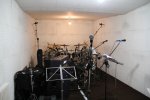Hello,
I do have a band (4 people: guitar, bass, drums, vocal) and in our reharsal room we do have a 4-auxes mixer, and each aux is connected to a headphone amplifier. Hence, each musician has a dedicated mix. However, more often than not it happens that one wants more of something (usually, more me or to modify some setting and you must access the mixer each time. I wanted to provide a way for each one to control his own mix where they are, even if not to a fully extent.
or to modify some setting and you must access the mixer each time. I wanted to provide a way for each one to control his own mix where they are, even if not to a fully extent.
There are some commercial solutions out there like Hear Technology Hear Back System, or Behringer Powerplay P16 (I + 4M units) but I wanted to spend less. So let's assume each of us can use a behringer Micromix (or similar) which mixes 4 signals.
Is there a way to bring to each musician the same 4 signals at a reasonable price? In other words, if I get 4 signals out of the mixer (via direct out, sub, etc.) is there a way to "multiply" these signals 4 times and bring them to each musician? is there a patchbay or similar device that can act like that? It would be something like a switch for network use: you plug in a cable (a signal, in our case 4 of them) and the device transmits it on the other sockets (16: 4 x 4).
Any help is welcomed!
thanks,
Roberto
I do have a band (4 people: guitar, bass, drums, vocal) and in our reharsal room we do have a 4-auxes mixer, and each aux is connected to a headphone amplifier. Hence, each musician has a dedicated mix. However, more often than not it happens that one wants more of something (usually, more me
There are some commercial solutions out there like Hear Technology Hear Back System, or Behringer Powerplay P16 (I + 4M units) but I wanted to spend less. So let's assume each of us can use a behringer Micromix (or similar) which mixes 4 signals.
Is there a way to bring to each musician the same 4 signals at a reasonable price? In other words, if I get 4 signals out of the mixer (via direct out, sub, etc.) is there a way to "multiply" these signals 4 times and bring them to each musician? is there a patchbay or similar device that can act like that? It would be something like a switch for network use: you plug in a cable (a signal, in our case 4 of them) and the device transmits it on the other sockets (16: 4 x 4).
Any help is welcomed!
thanks,
Roberto




